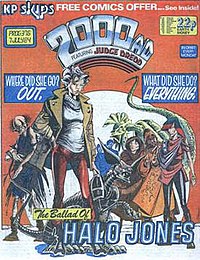Halo Jones
| Halo Jones | |
|---|---|

Halo's first appearance, on the cover of 2000AD (July 1984)
|
|
| Publication information | |
| Publisher | IPC Media (Fleetway) to 1999, thereafter Rebellion Developments |
| First appearance | 2000 AD No. 376 (7 July 1984) |
| Created by |
Alan Moore (script) Ian Gibson (art) |
The Ballad of Halo Jones is a science fiction comic strip written by Alan Moore and drawn by Ian Gibson, with lettering by Steve Potter (Books 1 & 2) and Richard Starkings (Book 3).
Halo Jones first appeared July 1984 in five-page instalments in the pages of the weekly British comic 2000 AD and is regarded as one of the high points of 2000 AD. The eponymous heroine is a highly sympathetic 50th-century everywoman, and the tone of the strip runs from the comic to the poignant. The three "books" span more than ten years of her life, and also serve as a tour of the well-realized futuristic universe which Moore and Gibson created. Originally, Halo Jones was planned to run to nine books, chronicling Halo's life from adolescence through old age. However, the series was discontinued after three books due to a dispute between Moore and Fleetway, the magazine's publishers, over the intellectual property rights of the characters Moore and Gibson had co-created.
The three books in the series are:
Other places she had visited or spent time in included Proxima IV, Vescue, Sirius, Skinner's World, and Popotoplec. Although it is mentioned that she met the famous historical figure Sally Quasa, this meeting does not take place in the first 3 books.
In his introductions to the three 1986 Titan editions, Moore described its genesis. The story was designed from the outset to avoid the typical 2000 AD story elements: "guns, guys and gore." Moore said that he had "no inclination to unleash yet another 'Tough Bitch With A Disintegrator And An Extra Y-Chromosome' upon the world". The idea to base the strip around an ordinary, unremarkable woman, typical of the society she lived in, was also very different for 2000 AD.
Gibson and Moore designed the world that Halo would live in with as much detail as possible. Book One may have been mildly criticised for dropping readers into a future world with no explanation of its societal structure, culture, language etc., but on closer inspection the book was designed to reveal aspects of this carefully constructed world in subtle and clever ways. The creators introduce us to 50th century politics, social problems, diet (vegan), cults, music, futuristic slang, fashion and also an ongoing off-world war that is clearly taking place in the background.
...
Wikipedia
